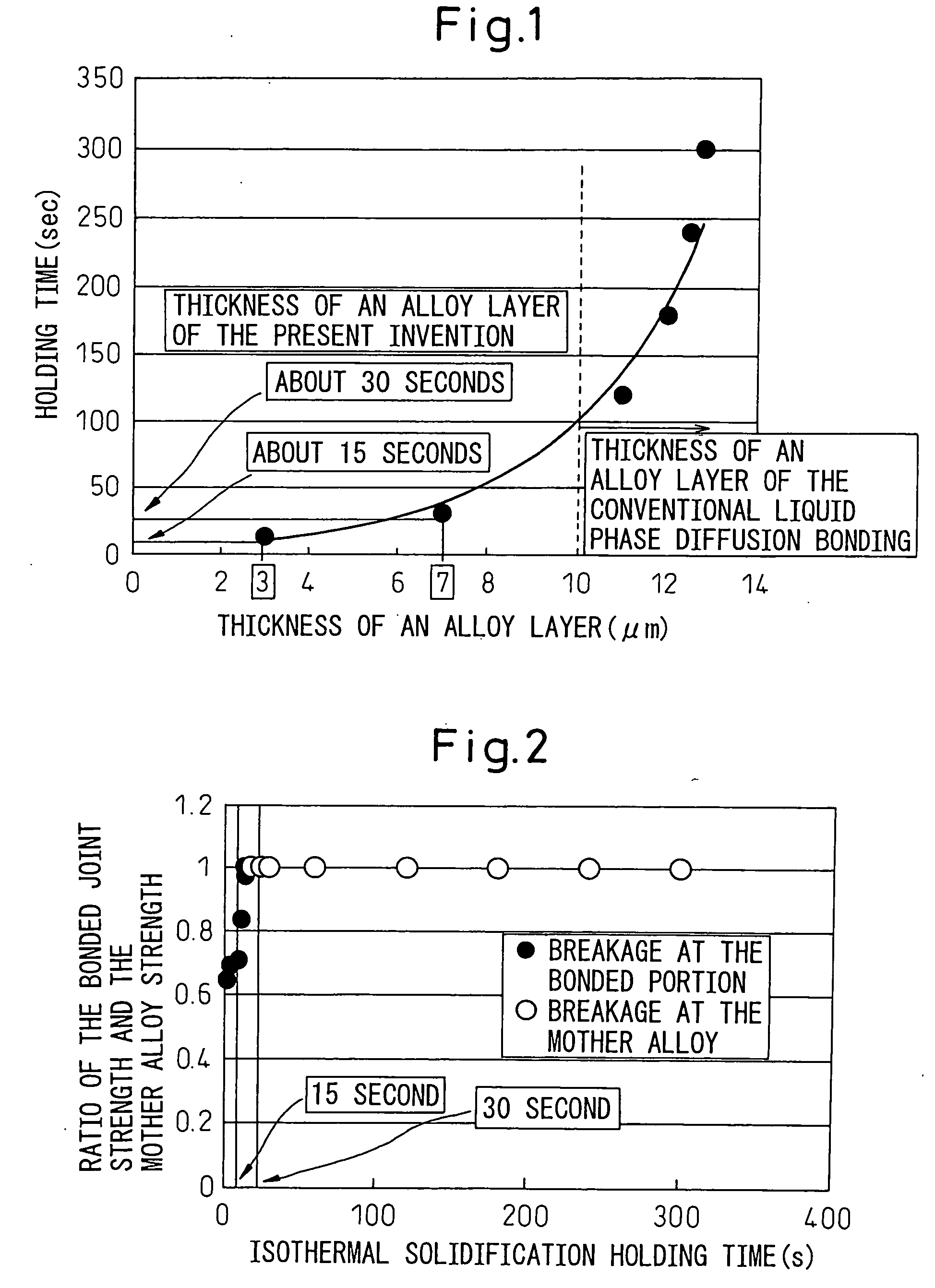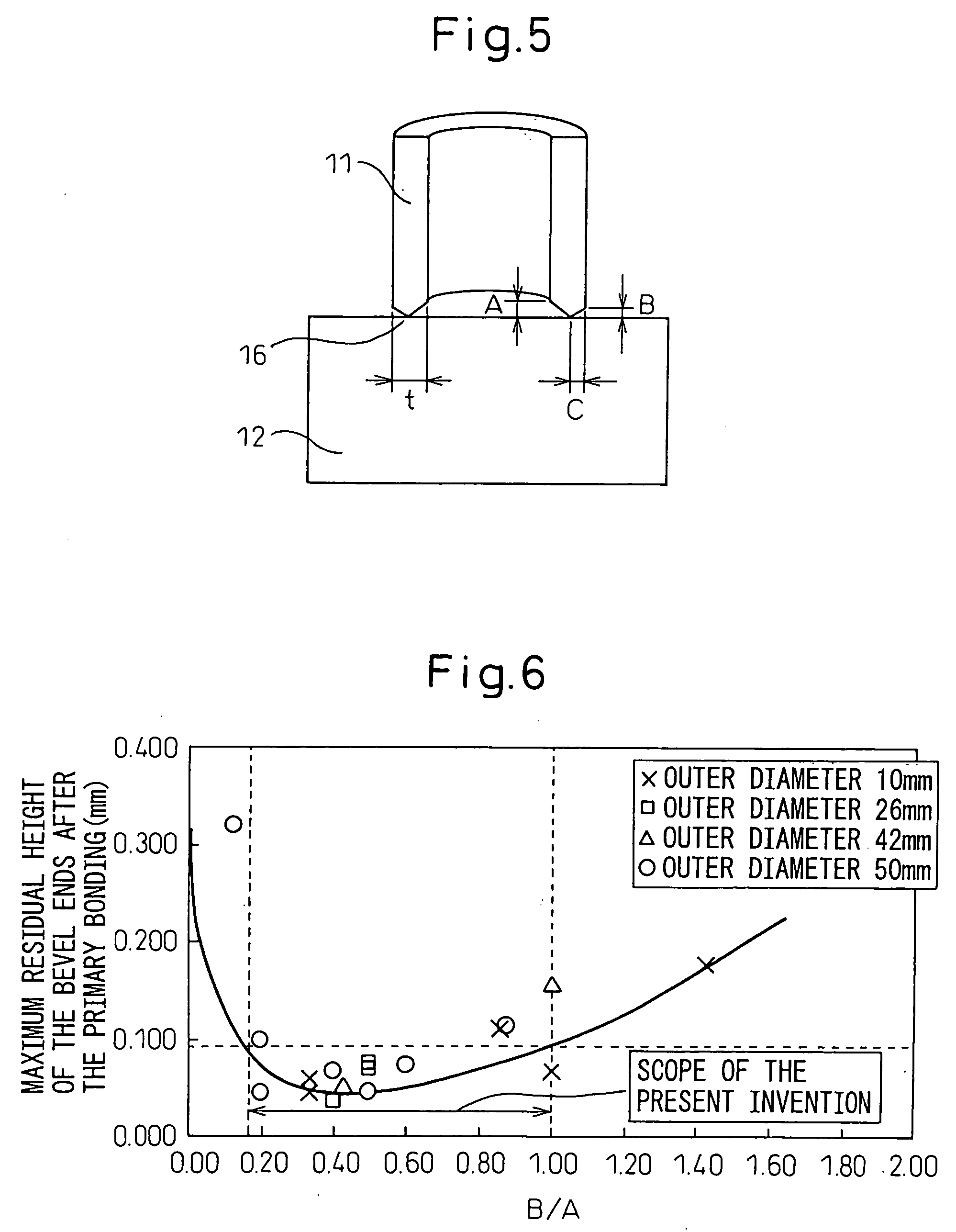Liquid phase diffusion welding method for metallic machine part and metallic machine part
a liquid phase diffusion welding and metallic machine technology, applied in non-electric welding apparatus, machines/engines, cams, etc., can solve the problems of limited reduction of alloy foil thickness, and limited diffusion of isothermal solidification, so as to improve the quality of the joint, improve the tensile strength, and reduce the effect of welding tim
- Summary
- Abstract
- Description
- Claims
- Application Information
AI Technical Summary
Benefits of technology
Problems solved by technology
Method used
Image
Examples
example 1
[0093] Amorphous alloy foils for liquid phase diffusion bonding having the three types of chemical compositions of the symbols A to C and melting points shown in Table 1 and bonded materials comprised of ferrous metals, Ni alloys, or Ti alloys having the chemical compositions of the symbols a to f shown in Table 2 were used to produce metal machine parts under the bonding conditions shown in Table 3 and Table 4.
[0094] The metal machine parts obtained were subjected to tensile tests in the direction pulling away from the bonded surfaces and charpy impact tests of the bonds at 0° C. and were evaluated for joint strength and joint toughness. Further, the amounts of deformation of the metal machine parts in the direction of application of bonding stress were measured and the amounts of deformation evaluated. The results are shown in Table 3 and Table 4.
[0095] Note that in Table 3 and Table 4, the evaluation of the joint strength is shown by the ratio of the tensile strength of the bon...
example 2
[0108] Next, the same procedure as in the invention examples of Nos. 2 to 8 shown in Table 3 of Example 1 was followed to bond branch pipes 2 and pipe bodies 1 shown in FIG. 8. At that time, as shown in Table 5, Table 6, and Table 7, metal machine parts bonded under conditions changing the dimensions of the thickness t etc. of the branch pipes 2 of the cylindrical metal materials and the bevel conditions of the branch pipes 2 (inner surface bevel height A, outer surface bevel height B, and distance C from abutting contact point to outer circumference) at the time of abutting were produced and were measured and evaluated for joint mechanical properties, in particular the fatigue strengths. Note that the chemical compositions of the amorphous alloy foils for liquid phase diffusion bonding and bonded materials used were the same as in Example 1. Further, the same procedure as in Example 1 was used for production except for the bonding conditions shown in Tables 5 and 6.
[0109] The meta...
example 3
[0121] Next, an explanation will be given of an example of application of the bonding method of the present invention when producing hollow metal machine parts such as various types of motor cam shafts fabricated conventionally by casting, forging and cutting, etc. as shown in FIG. 9.
[0122] Liquid phase diffusion amorphous alloy foils having two types of chemical compositions of the symbols A and B and melting points shown in Table 1 and bonded materials comprised of ferrous metals having the chemical compositions of the symbols “a” and “b” shown in Table 2 were used to produce metal machine parts shown in FIG. 9 by the following procedure under the bonding conditions shown in Table 8.
[0123] That is, as shown in FIG. 9, the end of a hollow metal material 18 forming one bonding face was machined in advance to give a V-bevel having an angle of 45°. The bonding faces of the bevel 19 of the hollow metal material 18 and the metal material 20 were made to abut against each other through...
PUM
| Property | Measurement | Unit |
|---|---|---|
| holding time | aaaaa | aaaaa |
| time | aaaaa | aaaaa |
| grain size | aaaaa | aaaaa |
Abstract
Description
Claims
Application Information
 Login to View More
Login to View More - R&D
- Intellectual Property
- Life Sciences
- Materials
- Tech Scout
- Unparalleled Data Quality
- Higher Quality Content
- 60% Fewer Hallucinations
Browse by: Latest US Patents, China's latest patents, Technical Efficacy Thesaurus, Application Domain, Technology Topic, Popular Technical Reports.
© 2025 PatSnap. All rights reserved.Legal|Privacy policy|Modern Slavery Act Transparency Statement|Sitemap|About US| Contact US: help@patsnap.com



